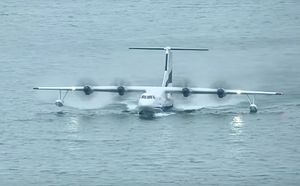China’s indigenously designed and built Kunlong (Water Dragon) AG600 amphibious aircraft successfully conducted its first water takeoff and landing on the Zhanghe reservoir near Jingmen city in Hubei province on October 20, according to local media reports.
“At around 8:51 a.m.[local time], the plane took off from the surface of a reservoir near Zhanghe Airport of Jingmen under the command of captain Zhao Sheng and his crew,” Xinhua news reported on October 20. “It landed smoothly and steadily on [the] water after a 14-minute flight.”
The seaplane’s first waterborne take-off follows the successful completion of high-speed water taxiing trials on the Zhanghe reservoir in early October. Prior to that in August, the AG600 conducted a ground training flight from an airport in the city of Zhuhai in south China’s Guangdong province to an airport in Jingmen, a city in central China’s Hubei province. The aircraft made its maiden flight, which was broadcast live on Chinese television, in December 2017.
The AG600 program was officially launched in 2011. Construction of the first AG600 prototype, under the auspices of the Aviation Industry Corporation of China (AVIC), began in 2014. The first Boeing 737-sized AG600 aircraft was rolled out at an AVIC plant in Zhuhai in July 2016. It is China’s third largest aircraft ever built, following the Y-20 military transport aircraft and the C-919 commercial passenger airliner. As I noted earlier this month:
The AG600, powered by four WJ-6 turboprop engines, is 37 meters long and has a wingspan of 38.8 meters. It can carry 50 people and can stay airborne for up to 12 hours. The plane’s maximum take-off weight is 53.5 tons, its maximum cruising speed 500 kilometers per hour, and the maximum operational range without refueling about 4,500 kilometers, according to AVIC.
The lower surface of the aircraft’s body is V-shaped for better stability during meteorological challenging conditions on water. According to AVIC, the aircraft can withstand two-meter-high waves. In December 2017, I explained the AG600 mission perimeters:
The AG600’s principal missions will be marine search and rescue operations and aerial firefighting. The seaplane can also be used for military operations to support Chinese maritime defense needs, including transporting supplies and military personnel to Chinese-controlled islands in the South China Sea (…)
Assuming, as claimed by the plane’s developers, that the AG600 only requires a water depth of 2.5 meters for landing and take-off, it would be an ideal aircraft to supply some of China’s artificial features in the Spratly Islands given that they are surrounded by shallow waters.
According AVIC, the AG600 can make round trips without refueling from the southern island province of Hainan to James Shoal, a disputed small bank in the South China Sea administered by Malaysia but claimed by China as its southernmost territory.
Indeed, Xinhua reports that the aircraft “provides support for China’s marine monitoring and safety patrol.” Notably, the military utility of the aircraft, however, has been questioned by a number of senior People’s Liberation Army (PLA) officers since last year.
The aircraft is expected to be available for delivery to customers in 2022.
































